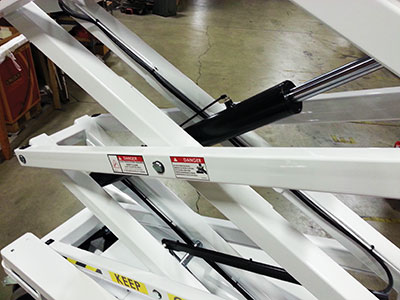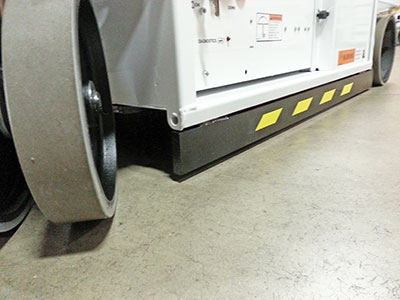
Safe design and operation
By J. Lynn Fraser
Features Tech tipsSteve Kissinger, president and owner of Custom Equipment (CE), operating since 1981, states that the most common source of failure that causes injury with lift platforms is a lack of proper training for workplace safety and area lift safety.
Steve Kissinger, president and owner of Custom Equipment (CE), operating since 1981, states that the most common source of failure that causes injury with lift platforms is a lack of proper training for workplace safety and area lift safety. As with most things in life, being proactive provides the best protection against accidents.
 |
|
| Checking retaining rings on the scissor structure is a critical part of the pre-use inspection. They can be knocked off by impact on a jobsite.
|
It is critical to keep in mind that the training for each type of equipment is specific to that machine. Different models of scissors have different functionality and training on one machine does not mean you are trained on all scissor lifts in the industry. For safety’s sake users must be aware of the capacities and limitations of the specific model they are using. That’s why they should pull out the operator’s manual and familiarize themselves with that exact model of the machinery, according to marketing manager, Justin Kissinger. “If the operator has never been on the HB-1030 model (that’s one of our machines) he should be reading the operator’s manual we provide,” Justin cautions. “But say he buys a Hy-Brid the first time and the second time buys a Genie. It’s a different machine, different brand, different model. They should always make sure they are familiarizing themselves with that machine based on that user manual.”
The International Powered Access Federation website, Kissinger advises, is a good place to get general safety on area work platforms. IPAF also advises operators to familiarize themselves with their specific model [and] how it operates. Steve notes that “ANSI [American National Standards Institute] sets the standard for the U.S. It is the dealer’s responsibility to make sure that they’re training all operators.” In Canada, the safety of elevated lift platforms is certified by different agencies in different provinces, but the Canadian Safety Standards certification is referenced by most and is certainly the most common across the country. “If the CSA documentation is there, the machine is safe,” Steve assures.
Accidents occur most frequently when machinery is not used properly. “Crushing, that’s happened. Mostly that happens on booms though, not as much on scissors. But there would not be a crushing hazard if people would not be putting a lift that goes to 26 feet in where you only have a 15-foot-high ceiling,” Steve Kissinger observes. Choosing the right machine for the task is always key.
Another common mistake is that users tie off extension cords around the railing and run them down and plug them into a wall. “What happens is, guys will come around the corner with a forklift or something like that, catch that cord and pull the machine over,” Steve points out. “The machine is designed to be plugged in at the bottom so that can never happen. If a machine is improperly maintained, if it doesn’t have power…most machines come with power to platform.” It is an example of how a seemingly minor maintenance oversight – a non-functioning power outlet – can lead to a tragic mishap.
Marking out the machine’s territory of use is also important. “Machines get hit by forklifts or somebody driving some piece of equipment when they don’t have their work area properly marked off so that people know that they’re working around there,” Steve Kissinger notes.
 |
|
| Scissor lifts come with active and passive pothole protection. Understand the difference to make sure you are getting the right kind of machine for your operation.
|
Using equipment in the way it was designed for is critical. “Standing on the railings would be an improper use. It is a user violating what the machine was designed to be doing, which is to keep you in a railing system for enclosure,” Steve Kissinger says. He adds that “non-manufacturer certified additions to the machine” shouldn’t be made. Examples of these additions include putting hooks on the side or putting pipes on the side. Unauthorized additions change the machine’s centre of gravity. They are also not manufacturer tested or certified and are therefore dangerous. Overloading is another problem as the machines are designed to carry specific weight capacities.
Use proper safety gear. Manuals specify the types of gear needed, Steve Kissinger says. “On scissor platforms, there is controversy over whether the railings provide the protection for you versus putting on a harness,” he notes. “It is typically up to the operator or the contractor if they want to use those added protections or not.” Justin, Steve and the IPAF have mixed feelings about the protection lanyards provide. They fear they might actually encourage risk-taking because the user feels protected. Justin notes that the user has to make sure they have a proper lanyard of the right length for the correct model, or risk using a lanyard that does nothing for safety at all.
Safety and maintenance help keep risk of injury low. Keeping equipment clean ensures that it operates in a predictable and therefore safe manner. Steve comments, “It is a huge thing because you don’t know if you have had anything drop between the scissors and you are crushing things.” Justin suggests giving the lift a 15-minute pre-inspection as you would an airplane that needs a visual inspection by its pilot before a flight.
“There are pre-start inspections we provide in the manual. Equipment should be inspected daily. I would say that most of the time that doesn’t happen,” Steve notes with regret.
A user’s “pre-flight” check should include an inspection of “all machine components for missing parts and obvious damage including torn or loose hoses; hydraulic leaks; torn, frayed or disconnected wires; and damaged, dented or bent structural members,” Justin says. “Replace boards if necessary. Check the hydraulic fluid level when the platform is fully lowered. Check the tires for damage. Check the wheel axle retaining rings and set screw in rear wheel are tight. Check the hoses and cables for worn areas or chafes and replace as necessary. Check the platform rails and safety gauges for damage. Make sure the gate closes properly. Check all snap rings are secure and grooves on pivot pins. Check the warning and instructional labels are legible and secure.”
“The retaining rings are on the scissors,” Steve Kissinger adds. “They are the ones that hold the machine together. You want to make sure that all of them are in there. You just never know. You run it into a doorway, maybe you damaged something, knocked a ring off or maybe somebody came along and banged into the machine or something and knocked the retainer off. On job sites, anything can happen.”
Justin advises the user should “inspect the platform controls and ensure the load capacity is clearly marked. Check the base control for proper operation. Check all switches and push buttons for proper operation. Check the platform controls for proper operation. Check all switches, and push and push buttons on upper control for proper operation also. Brakes, the machine stops when the joystick is released and check the pothole guard is in place and lock when the platform is raised.” The Kissingers caution that these steps are only a partial list of what should be done to inspect a machine, and rental operators should always consult an operator’s manual for a comprehensive safety checklist.
Steve says there are important differences between active and passive pothole protection that rental operators should be conscious of when choosing a machine. “Active pothole systems are ones where there’s a bar that will flip down between the wheels when the machine elevates past a pre-set height,” he says. “The bar is designed so that if you are elevated and you are driving along and you fall into a manhole, the machine will not tip over.” The bar also prevents the machine from “just tipping and going down” at the end of a loading dock because “the machine will fall down onto the bars and it will stop the machine from moving and it will just sit on the bars between the front and rear wheels.” Passive systems use a bar that stays in place at all times, rather than moving into position only when the platform goes up. These systems are less expensive, but the bars can get in the way around job sites and when loading the scissor lift on to a flatbed.
Paying attention to the health of the hydraulics system is important for user safety too. Steve Kissinger notes that a burst hydraulics line means users will contaminate the whole work area. He warns, “if you have a hose that is frayed and you are up on the platform, that is all that is holding you up in the air.” Custom Equipment’s machines use safety valves that prevent a freefall, but Steve warns, “you never want to go up on a machine with a hydraulic leak or anything because you are asking for trouble there.” To prevent falls due to hydraulic failure, Custom Equipment uses a velocity fuse that is installed at the base of the cylinder. Thus, Steve says, “if the flow rate becomes greater than what we have specified it to be, what will happen is the valve will close and it will lock the machine in that position. So in order to get the machine to be lowered at that point, you have to replace the hose and get an equal pressur on the other side of the valve to release the valve to make it operate again.” Steve adds that Custom Equipment does this on other machines, as well. “We’ll have a holding valve that is designed right into the cylinder, right at the base of the cylinder. There are reasons for doing it different ways in different countries.” Custom Equipment, Steve notes, follows the Canadian Standard Association’s design rules in Canada.
Safety on a lift platform requires careful maintenance, daily pre-use inspections, as well as the creation of a safe operating environment. It also requires training and certification for each lift model for users and rental operators. Using check lists for maintenance, inspections, safety, training and certification is a proactive process that will reduce accidents.
Print this page
Leave a Reply